This L.A. marine mammal rescue center is at max capacity. Here’s how you can help

- Share via
When a sea lion is found stranded anywhere between Long Beach and Malibu, chances are a volunteer with the Marine Mammal Care Center in San Pedro will play an important role in its rescue. The center’s 250 volunteers help with every stage of the creature’s recovery, from its removal from the sand to its release back into the ocean.
I recently spent an afternoon at the center’s hospital in San Pedro and saw first hand what it’s like to be an animal care volunteer here. I came away with a new appreciation for not only the hard work and heroic team effort required but also the rewarding mix of fun and gratification it offers.
You are reading The Wild newsletter
Sign up to get expert tips on the best of Southern California's beaches, trails, parks, deserts, forests and mountains in your inbox every Thursday
You may occasionally receive promotional content from the Los Angeles Times.
The center is at maximum capacity right now, with 47 elephant seals, 37 California sea lions and eight harbor seals. Most of them are recovering from illness, injury or malnutrition. This year has been “uniquely challenging,” notes Chief Executive John Warner.

“We have admitted 65% more patients in the first five months of 2024 than we did during the same time frame last year,” he says. Warner said that the center is not yet sure of the reasons for the increase and that it continues to gather and analyze data to determine why.
The sea lions and seals consume as much as 1,000 pounds of fish a day and require constant care and monitoring. That’s where volunteers come in. Working in five- to six-hour morning and afternoon shifts, they wash dishes, do laundry, prepare fish “smoothies” for those unable to eat on their own, scrub pens and coax the sea lions and “ellies” (short for elephant seals) into plastic pools that simulate the water in which they’re accustomed to eating. All the while, helpers are keeping careful notes on changes in behavior and nutritional intake. Sometimes they hold animals in place while a veterinary technician draws blood or tube feeds them.
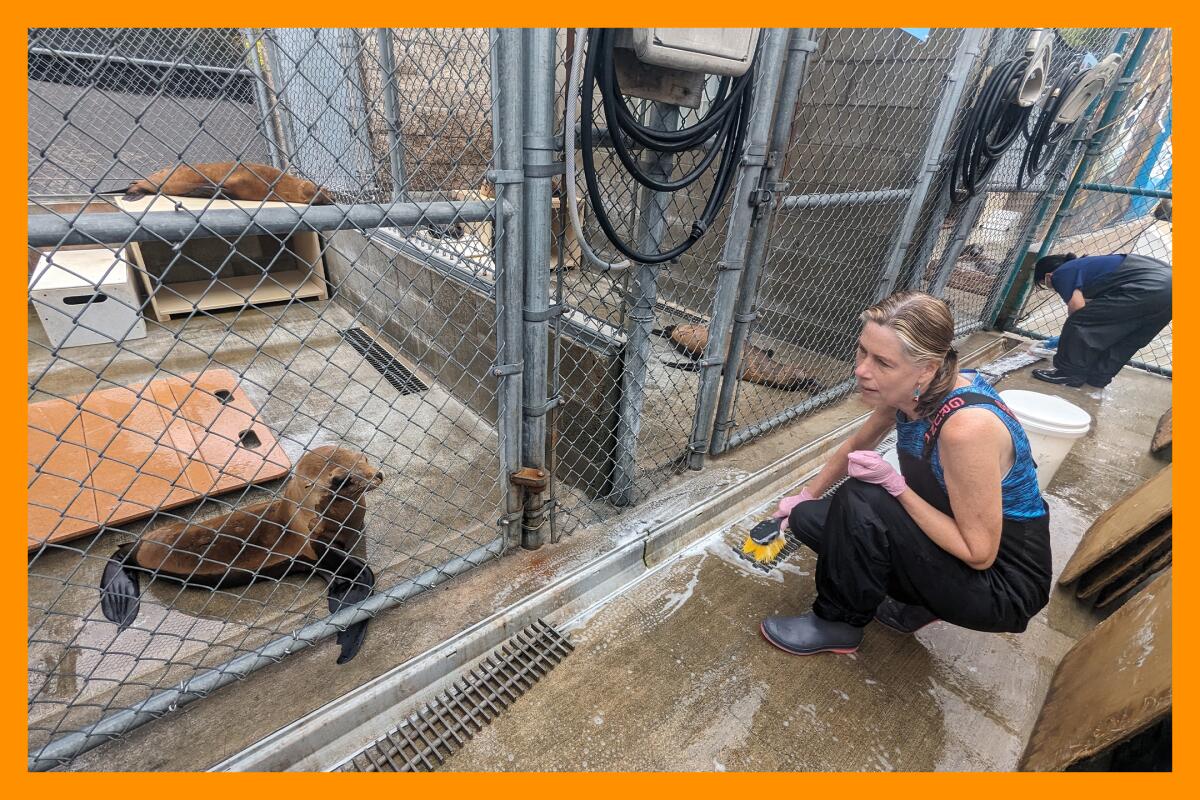
Tracey Lewis, a retired consultant from Westchester who has volunteered at the center since 2016, said she was intimidated at first by some of the tasks.
“I stuck with dishes and laundry at first,” she said. Then the staff convinced her that she was ready for tube feeding. “Now I do it all the time.”
One of the most rewarding experiences for Lewis was joining a chartered boat ride to the Channel Islands in April to release six sea lion pups into the ocean. They were born at the center in 2023, after their mothers were poisoned by a toxin caused by a harmful algae bloom and rescued by the facility last summer.
“We had spent nearly a year raising these guys,” Lewis recalled. “It was such a fun bonding event.”

On the afternoon I visited, the volunteer team joining Lewis was a mix of ages and backgrounds, including David Lee, a retired engineer from San Marino; Jennifer Muniz, an aspiring veterinary assistant who takes two buses from downtown Los Angeles to help out once a week; and Karen Ishii of San Pedro, who learned about the center after her brother got involved.
One thing they all had in common: the cheerful acceptance that no one is above any task. They hose down poop-filled basins, coax errant sea lions back into their pens and use trash pickers to lower herring into the mouths of those having trouble eating on their own. (Unlike at dog and cat shelters, volunteers here are taught to maintain minimal interaction with the animals to prepare them for their return to the sea.)
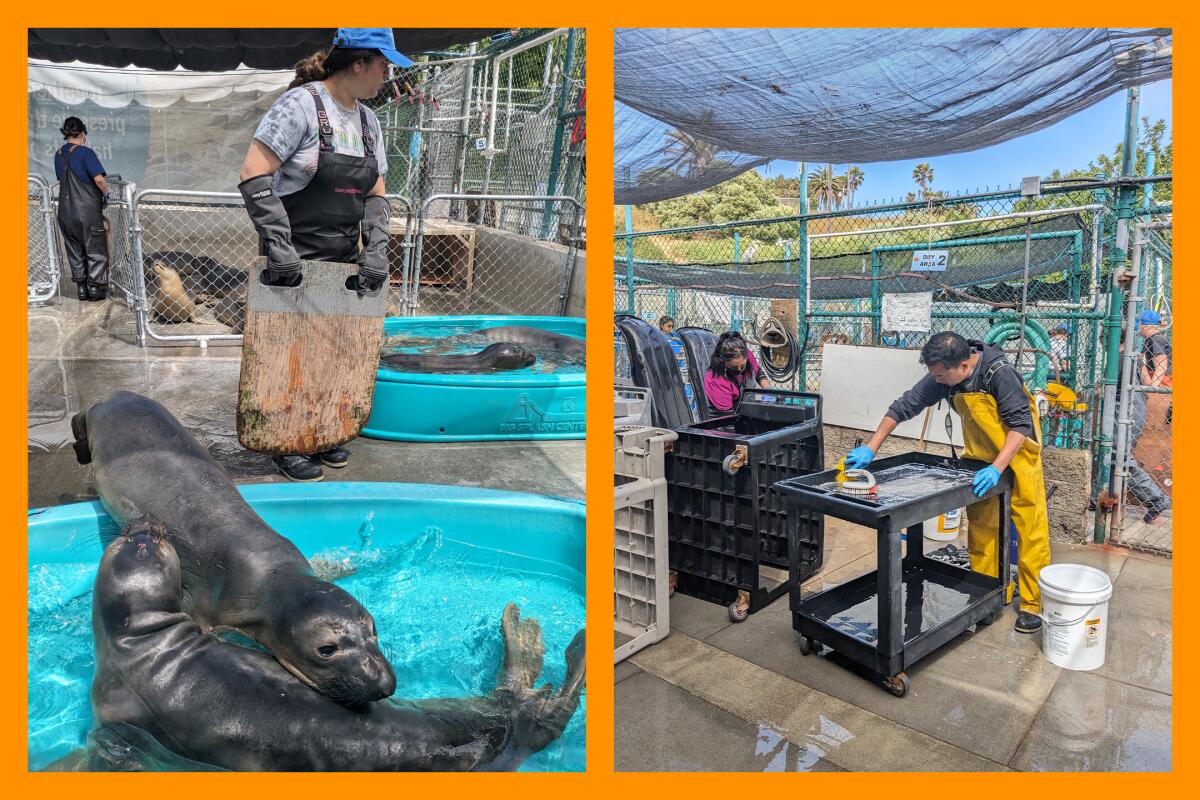
Sam Gattlin discovered the marine mammal center soon after moving to San Pedro from the U.K. Now, he comes by after work once a week to help clean up after the third feeding of the day.
“The first thing I noticed when I moved here was the rugged beauty of the area,” Gattlin said as he scrubbed a pool where an elephant seal had just finished gobbling up herring. “It made me realize I need to get off my laptop and give back to nature.”
Other opportunities
Animal care isn’t the only option available to volunteers at the Marine Mammal Care Center. They also organize release events, work as docents and staff the gift shop (the center is open to the public from 10 a.m. to 4 p.m. Friday through Monday). Others belong to the Pinniped Patrol, a group of on-call volunteers who rush to the site of reported strandings to protect beached animals until help arrives. For more information, visit marinemammalcare.org.
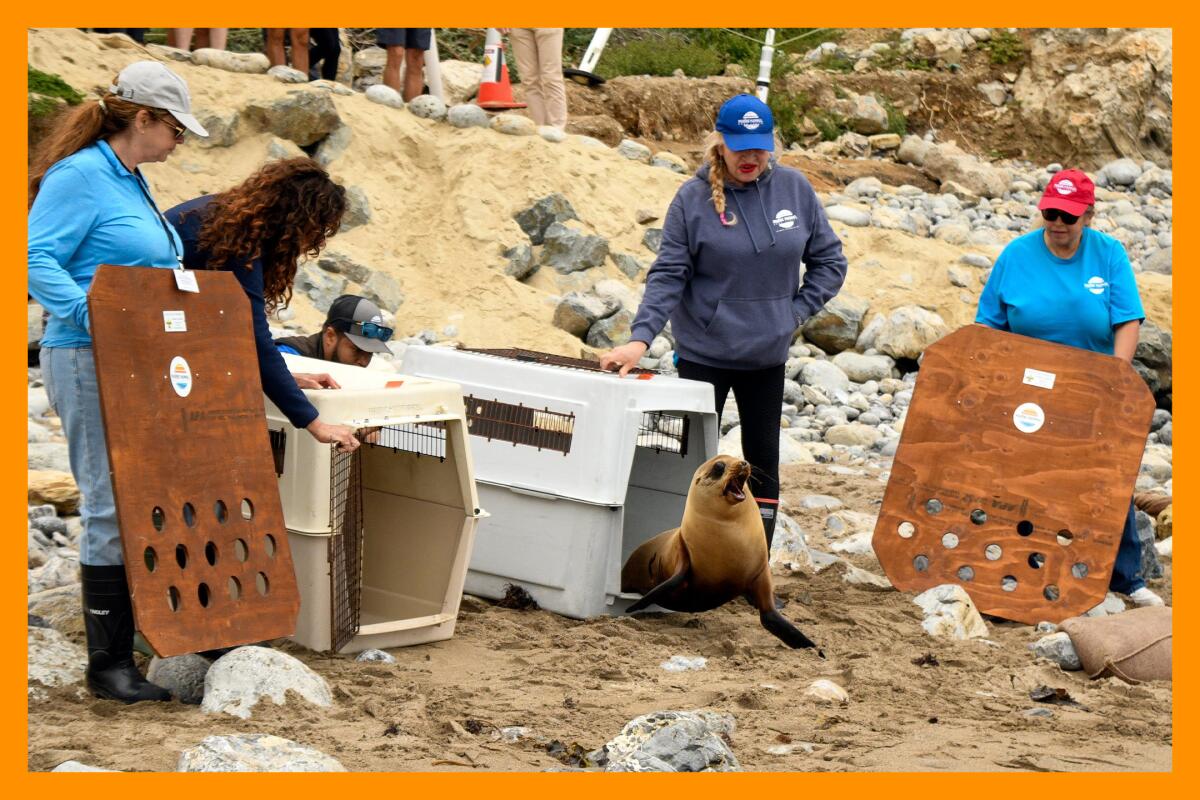
One last thing
If you see a sick or injured marine mammal anywhere between Long Beach and Malibu (including Catalina Island), the best way to help is to leave it alone and call the MMCC Rescue Hotline at (800) 39-WHALE .

3 things to do
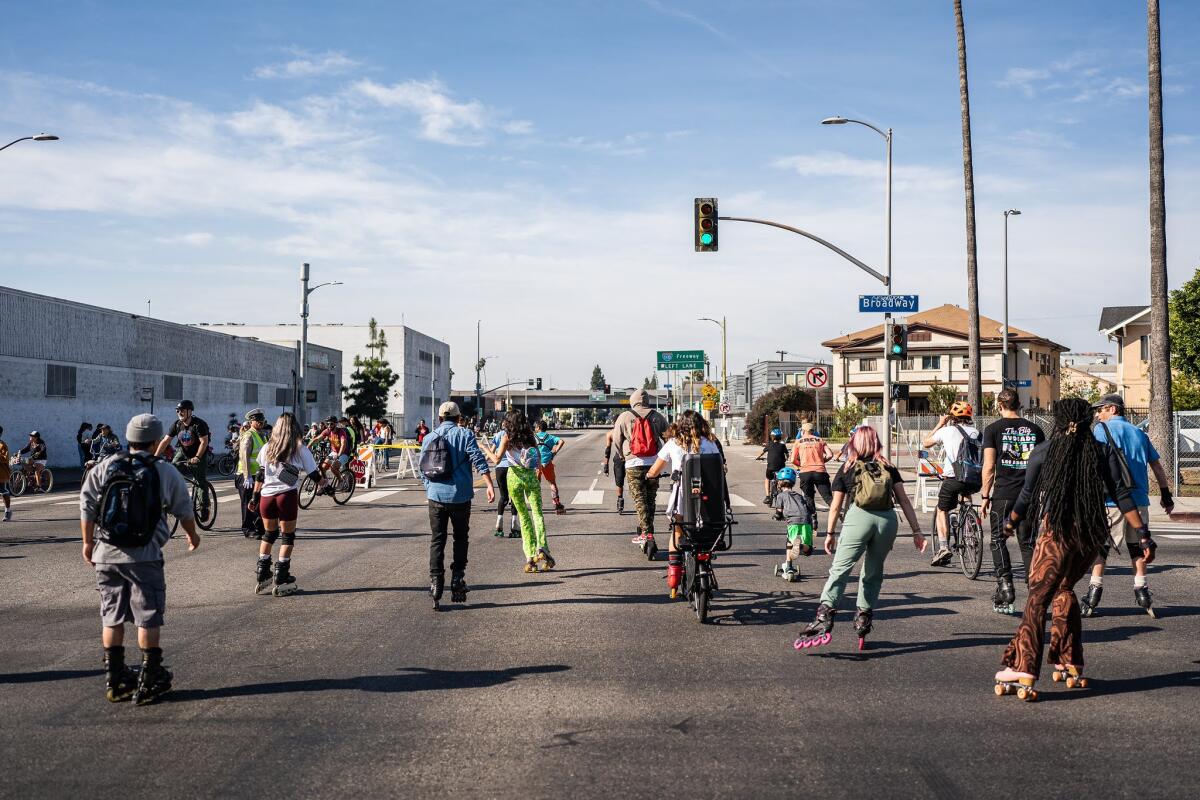
1. Ride your bike in South L.A.
Jog, walk, bike or skate Sunday along five miles of car-free Western Avenue between Exposition and Century Boulevards at CicLAvia’s 53rd event. All people-powered modes of transportation are welcome at the event, which features street games, family-friendly activities and free basic bike repairs. It takes place between 9 a.m. and 4 p.m. For more information and a digital map, visit ciclavia.org.
2. Join a hiking book club in Santa Clarita
Every month, on the fourth Sunday, trained docent naturalists lead a moderate hike at Placerita Canyon Nature Center that ties in with a specific book chosen for its sustainability or environmental themes. This Sunday, the group will tackle the novel “The Trail” by Ethan Gallogly, about a man who hikes the John Muir Trail after his father dies and he loses his job. The leaders tie in relevant sections of each book to the wildlife and plants of Placerita Canyon. The hike takes place from 8 to 10 a.m. and begins at Acorn Amphitheater. Reservations aren’t required but are encouraged by sending an email to [email protected]. For more information, visit placerita.org.
3. Make a splash in Santa Monica
The historic mosaic-tiled pool at the Annenberg Community Beach House is open for the season. Day passes ($10 adults, $4 youth ages 1 to 17) include all-day access to the heated pool, deck, changing rooms and lockers. Here are a few things to know before you go: Passes are available one hour before opening and sold on a first-come, first-serve basis. All members of your party must be present. The beach house has a great wait-list system, so don’t be discouraged if you don’t get tickets at first. You can go to the beach and you’ll be texted when spaces open up. Parking in the adjacent lot is $12 a day; there are additional lots to the south within walking distance. Hours are noon to 6 p.m. Monday through Thursday and 10 a.m. to 6 p.m. Saturday and Sunday. Bring your own towels.

The must-read
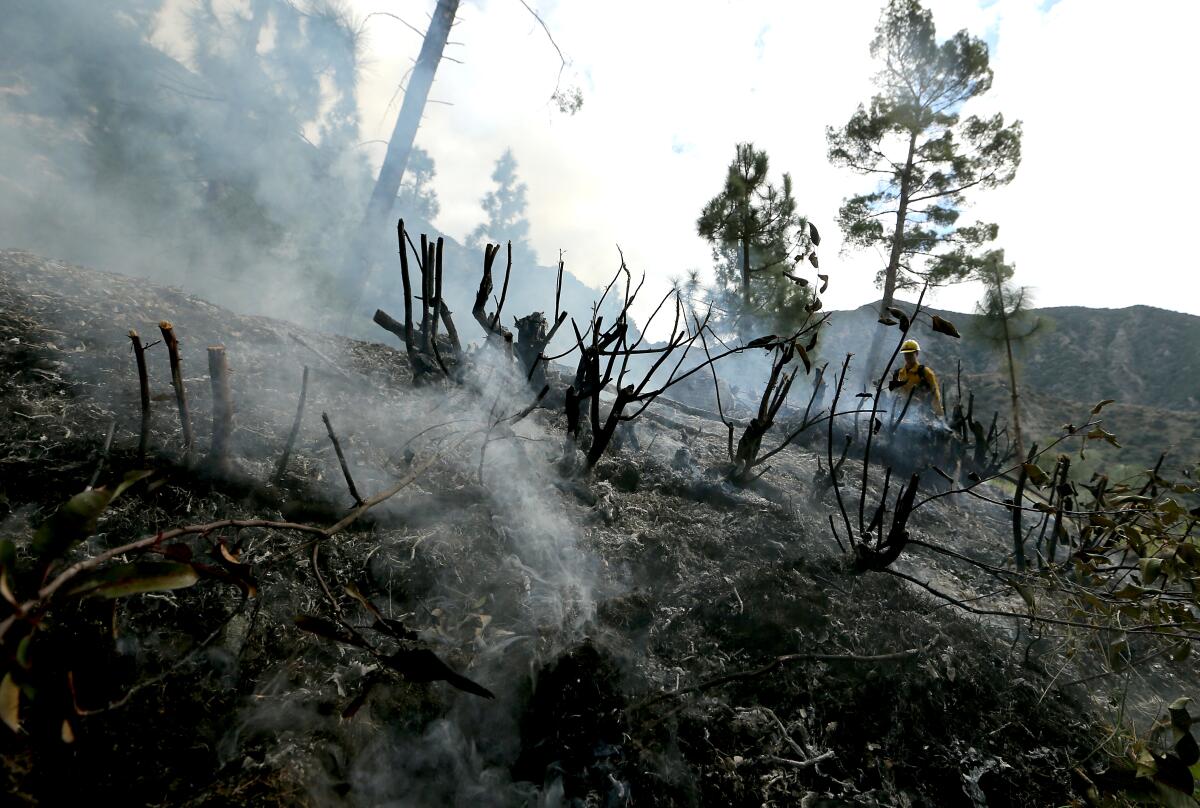
We are entering prime wildfire season, so it’s hard not to worry when even the faintest plume of smoke appears on our hillsides and mountain ranges. But not all fires are threatening, as Times reporter Alex Wigglesworth explains in her article about prescribed burns. That’s when firefighters intentionally apply flames to a landscape that has been carefully prepared, with the goal of lowering the risk of out-of-control wildfires by reducing the amount of burnable plant material when conditions are favorable. We can expect to see more of these prescribed burns, Wigglesworth reports, as California seeks to step up the practice and set fire to 400,000 acres a year by 2025.
Happy adventuring,

P.S.
The first full moon of summer (a.k.a. the Strawberry Moon) shows up Friday, and it will be the lowest hanging (read: big) full moon in years, according to the Old Farmer’s Almanac. Nature centers from Eaton Canyon to Stough Canyon and TreePeople have night hikes planned around it. If you can’t find a trek that suits you, just take a stroll in your own neighborhood after dark and enjoy the natural show.
For more insider tips on Southern California’s beaches, trails and parks, check out past editions of The Wild. And to view this newsletter in your browser, click here.
Sign up for The Wild
We’ll help you find the best places to hike, bike and run, as well as the perfect silent spots for meditation and yoga.
You may occasionally receive promotional content from the Los Angeles Times.




